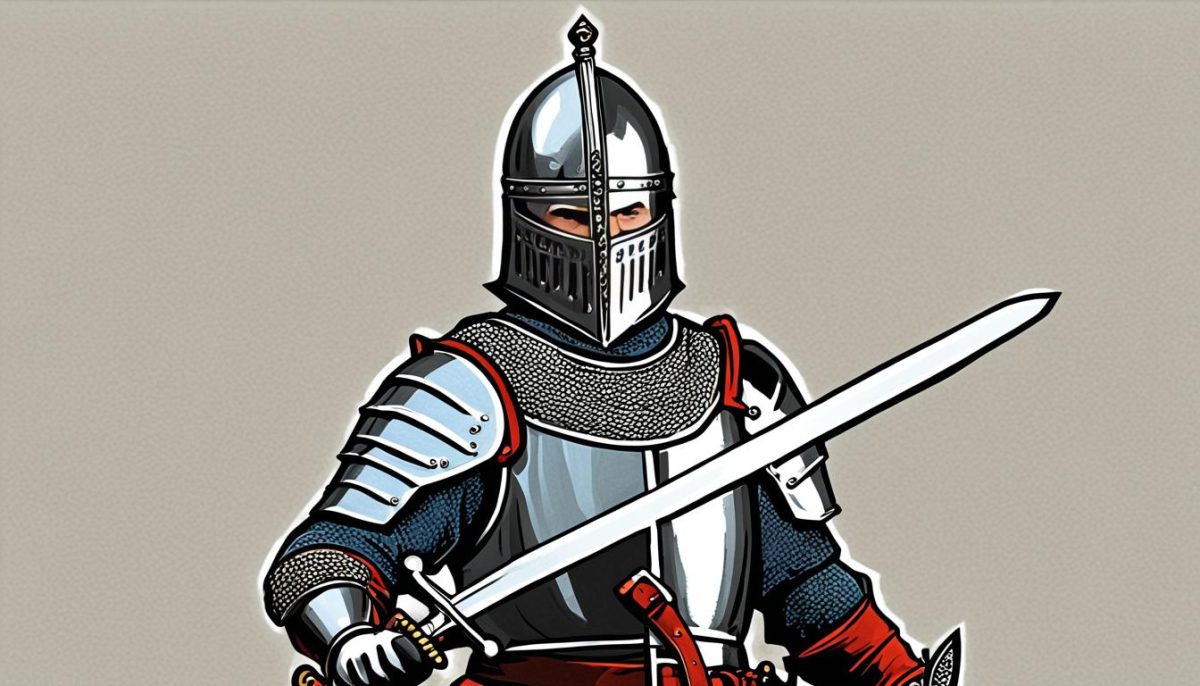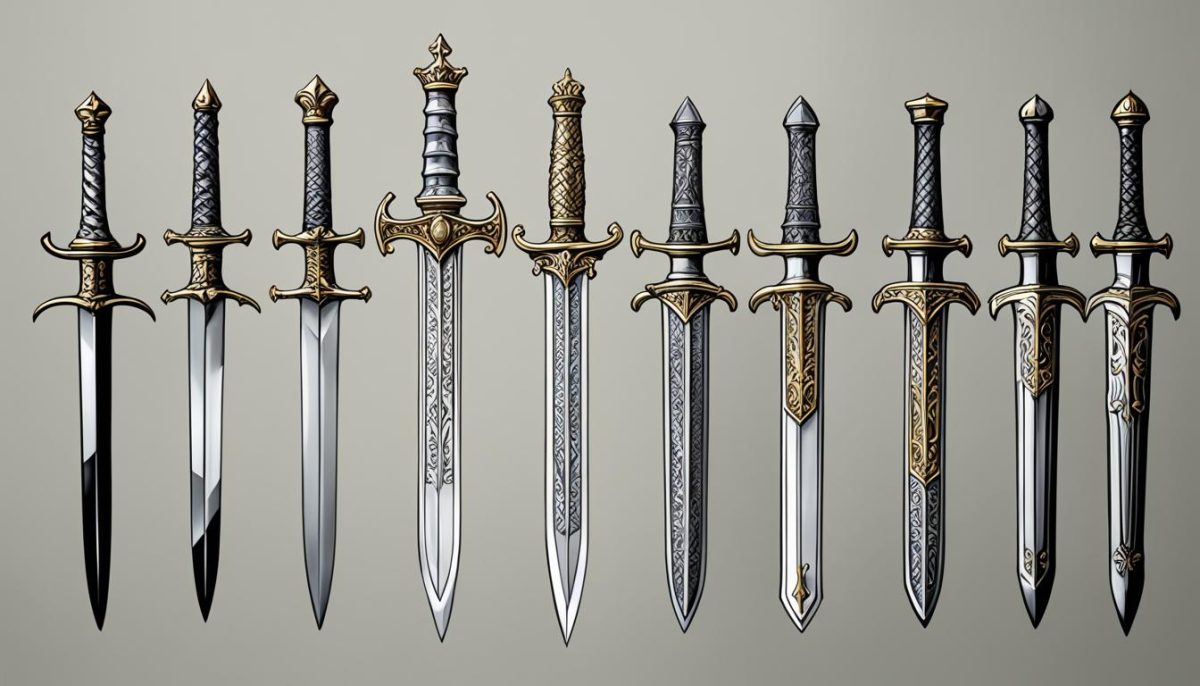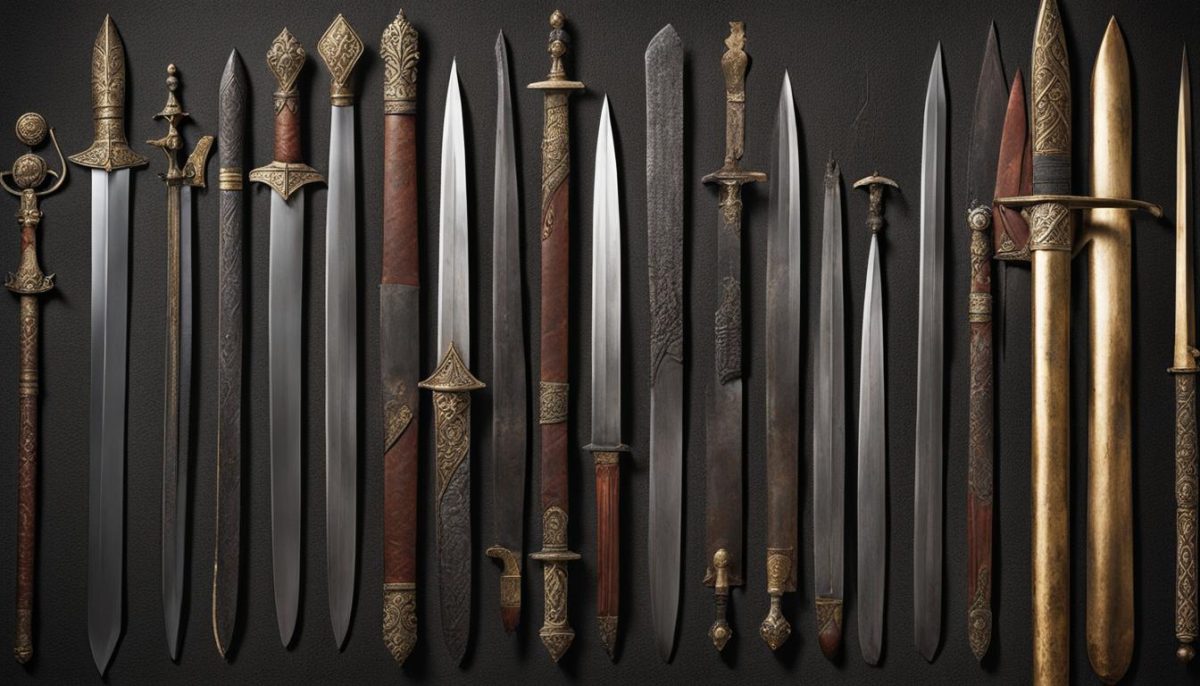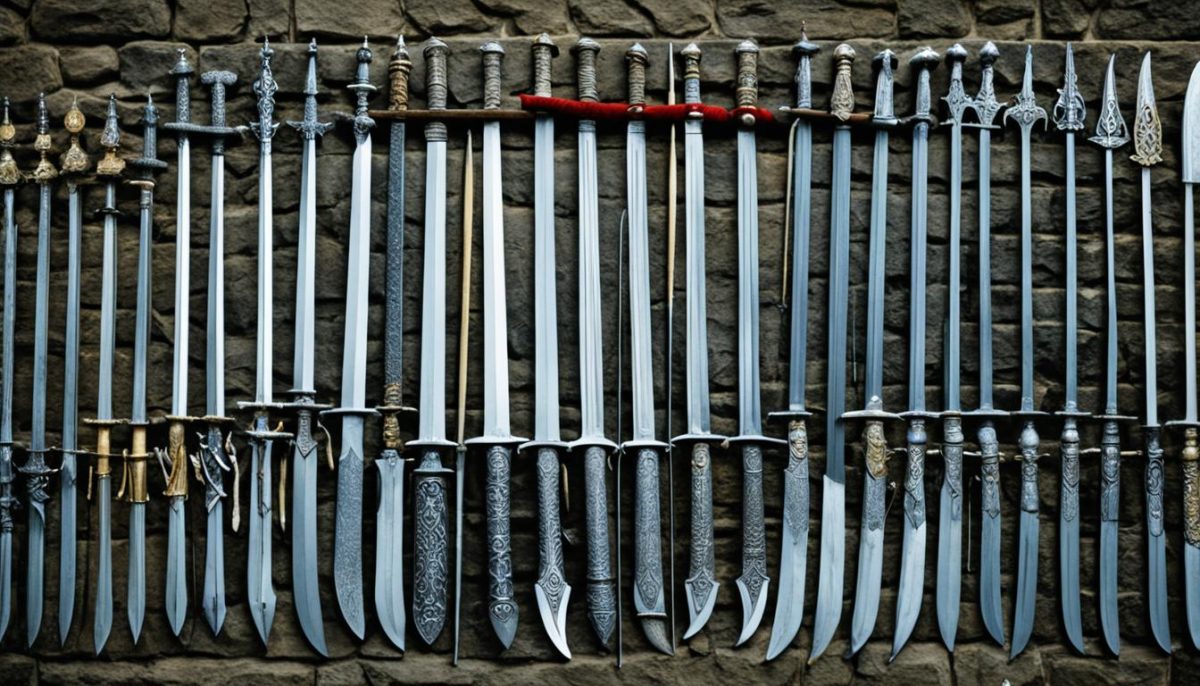The blade of history has left an indelible mark in our collective memory, where medieval swords hold a tale longer than their steel. The quest to understand the medieval swords length brings us to the heart of an era defined by warfare, honor, and craftsmanship. Across the tapestry of time, these historical swords have stood as emblems of power and artifacts of warfare that resonate with tales of valor.
Traversing the diverse geographical tapestry of European swords, we observe a striking variety in sword dimensions and builds. From the nimble one-handed arming swords to the mighty two-handed greatswords, each blade was a response to the martial needs and advances of its time. The length of these swords did more than determine reach; it spoke of social stature, technological prowess, and specialized combat tactics.
Feel the weight of history as we slice through centuries, from the heated forges of blacksmiths to the hallowed halls of The Wallace Collection in London, and understand the factors that molded the swords carried by knights into battlefields. Through meticulous examination, spearheaded by renowned scholars like Ewart Oakeshott, we unveil not just the dimensions of these blades but the stories they carry, engraved in their very steel.
Join us as we embark on this sharp journey back in time, cutting to the core of what made these bygone blades both a weapon and a work of art.
Historical Context of Medieval Swordsmanship
The Middle Ages were a period marked not only by strife and the clamor of battle but also by the remarkable evolution of knightly weapons and the craft of the blade. Medieval swordsmanship, an art refined over centuries of warfare and duels, stood at the heart of this era, as much a symbol of chivalry as it was a means of survival. Delving into the annals of history, we uncover the art and science that propelled the sword from a primitive tool of war to a testament to the era’s technological and cultural zenith.
Evolution of Sword Making Techniques
Remarkable strides in metallurgy and smithing during the medieval period were pivotal in shaping the sword making evolution. Early medieval swords, often derived from the Viking Age patterns, were simplistic yet functional weapons, forged with techniques that had yet to benefit from later innovations. As centuries progressed, so did the mastery of ironwork and the understanding of steel, leading to sophisticated designs that imbued warfare swords with greater strength, flexibility, and durability. Authors such as Sir Richard F. Burton, in “The Book of the Sword,” provide compelling narratives of how this progression was more than mere craft; it was an art form, deeply intertwined with the culture and technology of the time.
The impact of these advancements is evidenced by the transformation from early pattern-welded blades to the later, more refined swords of the Renaissance. “The Knight and the Blast Furnace” by Alan Williams chronicles the metallurgical innovations that allowed for greater variation in blade length, weight, and design—a mirror reflecting the changing nature of medieval conflicts and the ever-evolving demands of warfare.
Importance in Medieval Warfare and Knighthood
Within the ranks of medieval society, the sword was more than a weapon; it was a symbol of knighthood, honor, and status. Warfare swords were central to the chivalric code, embodying the virtues and responsibilities of the knightly caste. The historical reenactments and minute accounts of battles through the Middle Ages highlight the sword’s pivotal role, not only as a weapon of war but also as a ceremonial object imbued with significant sociopolitical connotations.
Chronicling the journey of the sword from a knightly weapon of war to an object of aristocratic virtue, we see a reflection of medieval society itself—a world where military might and noble lineage were inextricable from one another. The tradition of swordsmanship, passed down through generations of warriors, showcases the deep reverence for the skill and expertise required to wield these notable blades effectively in battle.
By appreciating the historical context of medieval swordsmanship, we gain not only insight into the art of combat but also a profound understanding of the cultural fabric that defined an epoch. The sword, an extension of the warrior’s will, persists as a powerful symbol of an age defined by its devotion to mastery, valor, and the relentless pursuit of excellence in the forge and on the field of battle.
Understanding Long Medieval Swords
The term “long sword” typically refers to both two-handed swords and sizeable one-handed swords of the medieval era. These long swords, symbolic of medieval weaponry and prowess in swordsmanship, were more than just weapons; they were a hallmark of status and skill. To fully appreciate these historical armaments, one must delve into their defining features, types, and the techniques crafted around their use.
Within the realm of long swords, the greatsword and the Scottish claymore stand out. Greatswords, known for their formidable size and reach, were predominantly wielded with two hands due to their significant weight and length. Claymores were similarly grand but featured distinctive forward-sloping quillons. These swords were not just larger versions of standard swords; they possessed specific design characteristics that catered to their roles on the battlefield, emphasizing strength and leverage.
- Greatswords: Often exceeding 50 inches in total length, with a broad, double-edged blade suitable for powerful slashing and thrusting in open combat.
- Claymores: Typically around 55 inches long, used for both cutting and thrusting, featuring an iconic cross-hilt with quatrefoil designs.
The effective use of long swords in warfare required specialized training to master the handling characteristics and combat techniques. Historical combat manuals, like Fiore dei Liberi’s “Fior di Battaglia,” provide insights into the martial discipline that governed the use of these majestic weapons.
“To control the great sword, one must harmonize strength with precision, for its power is unmatched when directed with skill.” – Fiore dei Liberi
Insight into the practical use of these swords is further substantiated by the comprehensive analysis of long swords on display at prestigious institutions like the Metropolitan Museum of Art’s Arms and Armor department. Here, one can visualize the grandeur and the intricate design elements that make each sword unique, reflecting its historical context.

Exploring different types of long swords underscores the evolution and diversification of medieval weaponry. The legacy of these swords continues to impact the study of swordsmanship and contributes to a deeper understanding of medieval combat tactics and the soldiers who wielded these legendary arms.
Variations in Medieval Sword Designs
The medieval era exhibited an array of sword design variations, each tailored for specific combat situations. Remarkable differences in style, length, and function can be observed when comparing the robust greatsword with the more modest-sized arming sword. Moreover, regional swords from across Europe reveal the adaptive nature of these weapons to local martial practices and cultural preferences.
The Greatsword Versus the Arming Sword
The greatsword and arming sword represent two distinct sword types that were prevalent across medieval battlefields. The greatsword, with its imposing length and heft, required two hands to wield and was effectively used for sweeping strikes and holding back multiple adversaries. In contrast, the arming sword was designed for one-handed use, often paired with a shield or buckler, offering agility and precision in close combat.
| Sword Type | Length | Weight | Use in Combat | Typical Region |
|---|---|---|---|---|
| Greatsword | Up to 72 inches | 6-7 lbs | Two-handed sweeps | Central Europe |
| Arming Sword | Approx. 30-40 inches | 2-3 lbs | One-handed thrusts and slashes | Widespread across Europe |
Regional Differences in Sword Length
Regional swords show distinct characteristics influenced by the martial needs and styles of their respective lands. Scandinavian designs, for example, often featured longer, straighter blades ideal for thrusting in cloak-and-dagger techniques. Swords from the British Isles, such as the Scottish Claymore, were adapted to both cut and thrust, with high crossguards for better hand protection. Central European swords tended to have more intricate pommels and fuller blades to balance the heavy cavalry’s need for both power and maneuverability.
- Scandinavian Swords: Longer blades for thrusting techniques
- British Swords: Balanced for cutting and thrusting with high crossguards
- Central European Swords: Intricate designs suitable for mounted combat
Materials and Craftsmanship of the Era
The medieval period was not only a time of battles and chivalry but also an era that showcased the peak of forging craftsmanship. Swords from this time were as much a result of skilled labor as they were of the steel quality they were fashioned from. Master blacksmiths utilized the finest sword materials available, continuously improving their techniques to enhance the durability and efficacy of these revered weapons.
Steel Quality and Forging Techniques
The steel used in medieval swords had to be impeccable to ensure that the sword would not fail in battle. Advances in metallurgy and the advent of new forging techniques led to swords that could be made longer without sacrificing strength. This was partly due to the increased understanding of how to control the carbon content in the steel, a crucial factor that determines the hardness and flexibility of the blade. According to “The Sword in the Age of Chivalry” by Ewart Oakeshott, high-quality steel was a vital ingredient for producing durable swords that could withstand the rigors of warfare.
Influence on Sword Length and Durability
As forging techniques advanced, so did the ability to create longer and more resilient blades—a clear demonstration of the intricate bond between sword materials and the finished product’s performance. Longer swords could now be produced without the risk of becoming unwieldy or brittle, which had been a practical limitation in earlier centuries. Findings published in The Journal of Archaeological Science support this, indicating that medieval blacksmiths had indeed accomplished technical feats that influenced sword length and durability greatly, making the weapons not just effective in combat but also enduring artifacts of history.


